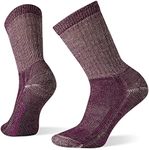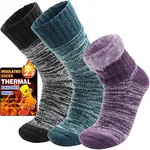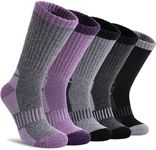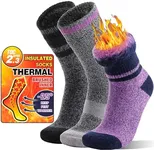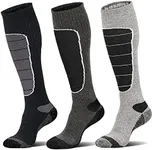Buying Guide for the Best Thermal Socks For Women
Choosing the right thermal socks for women involves understanding the key features that will keep your feet warm, comfortable, and dry in various conditions. Thermal socks are designed to provide insulation and moisture-wicking properties, making them ideal for cold weather activities or simply staying cozy indoors. Here are the key specifications to consider when selecting the best thermal socks for your needs.MaterialThe material of thermal socks is crucial because it determines the level of warmth, comfort, and moisture management. Common materials include wool, synthetic fibers, and blends. Wool is excellent for insulation and moisture-wicking, making it ideal for very cold conditions. Synthetic fibers like polyester and nylon are durable and often used for their moisture-wicking properties, suitable for active use. Blends combine the benefits of different materials, offering a balance of warmth, comfort, and durability. Choose wool for maximum warmth, synthetics for active use, and blends for a balanced option.
ThicknessThickness affects the level of insulation and comfort. Thermal socks come in various thicknesses, from lightweight to heavyweight. Lightweight socks are suitable for mild cold and everyday wear, providing moderate warmth without bulk. Midweight socks offer more insulation and are good for colder conditions or outdoor activities. Heavyweight socks provide maximum warmth and are ideal for extreme cold or prolonged exposure to low temperatures. Consider the climate and your activity level when choosing the thickness; opt for lightweight for mild cold, midweight for moderate cold, and heavyweight for extreme cold.
FitThe fit of thermal socks is important for comfort and effectiveness. A snug fit ensures that the socks stay in place and provide consistent insulation. Loose socks can lead to bunching and reduced warmth. Look for socks with a good elastic band around the top to prevent slipping and a contoured design that fits the shape of your foot. If you plan to wear the socks with specific footwear, make sure they fit well within your shoes or boots. Choose a snug fit for optimal warmth and comfort, and ensure they match your footwear requirements.
Moisture-WickingMoisture-wicking properties help keep your feet dry by drawing sweat away from the skin. This is important because wet feet can lead to discomfort and increased cold. Materials like wool and certain synthetic fibers are known for their moisture-wicking abilities. If you are engaging in activities that cause sweating, such as hiking or skiing, prioritize socks with good moisture-wicking properties. For everyday use, this feature is still beneficial to maintain comfort throughout the day. Choose socks with moisture-wicking properties to keep your feet dry and comfortable.
DurabilityDurability ensures that your thermal socks will last through repeated wear and washing. Look for reinforced areas such as the heel and toe, which are prone to wear and tear. Materials like synthetic fibers and wool blends tend to be more durable than pure wool. If you plan to use the socks for outdoor activities or frequent use, durability is a key factor. For occasional use, durability may be less critical but still important for long-term value. Choose durable socks for frequent or active use to ensure they last longer.
BreathabilityBreathability allows air to circulate, preventing overheating and maintaining comfort. This is especially important if you are active or wearing the socks for extended periods. Materials like wool and certain synthetics offer good breathability. If you are prone to sweaty feet or plan to wear the socks during physical activities, prioritize breathability to avoid discomfort. For general use, breathability contributes to overall comfort. Choose breathable socks to maintain a comfortable temperature and prevent overheating.




